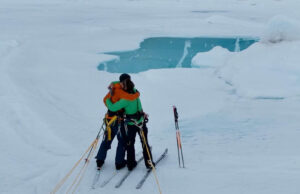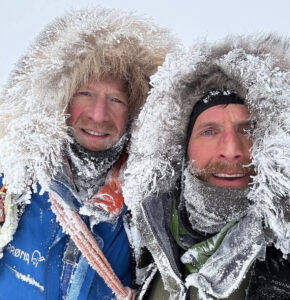Arctic travelers tend to view polar bears differently than folks down south. Having an animal that’s broken into your tent or scared the hell out of you on numerous occasions is not the same as enjoying some roly-poly white teddy bear on the Disney Channel.

Tent holes from another curious polar bear. Photo: Jerry Kobalenko
Nevertheless, today is International Polar Bear Day, and it’s worth dwelling on their continued presence in the Arctic. I’ve gone years between close encounters. Other times, I’ve had several on the same expedition.
My friend Bob Cochran and I were skiing 700km from Devon Island in Canada’s High Arctic toward Greenland. We were following in the footsteps of Frederick Cook in 1909. The controversial explorer overwintered on Devon Island with his two Inuit companions. The three of them then trekked back to Greenland.
Most of the route followed the east coast of Ellesmere Island. This lies on the edge of the North Water, the biggest polynya (area of permanently open water) in the High Arctic. Polar bears like a mix of open water and ice, so we expected a few close encounters, and we got them.

Site of the bears’ visit. Bob Cochran at Cape Norton Shaw, Ellesmere Island. Photo: Jerry Kobalenko
Near a ticklish spot called Cape Norton Shaw, where the open water pressed right against the coast, we camped on the sea ice inside a small bay. As usual, we set up our bear alarm fence around our tent and sleds. This homemade device makes a loud noise when the perimeter wire breaks, interrupting the current. The sound might frighten away polar bears, but its main use is to warn us before a nighttime visitor breaks into the tent.
I pre-cut the sections of perimeter wire, then twist them together lightly so they come apart more easily if a bear pushes against them. But this does lead to a few false alarms, especially in a wind.
That night while we were sleeping, the alarm woke us up. In late April in the High Arctic, it is light 24 hours a day. As usual, we sprang into bear crisis management mode. We grabbed our aerial flares — my favorite deterrent — plus our firearms as a last resort. Over the years, I’ve fired lots of warning shots but fortunately have never had to kill a polar bear.
We peered cautiously outside. Everything seemed in order. The sleds were in place and no white teddy bear came into view. We stepped outside. Nothing. One of those false alarms. I fussed with the fence and then reset it. We went back to sleep.
An hour or two later, the alarm went off again. I groaned. “I’ll go outside and fix it,” I told Bob. Nevertheless, just to be cautious, we went through the usual bear deterrent routine.
But when I peeked outside, my yellow-and-blue sled had moved several meters. It wasn’t windy. Foxes, the only other arctic animal that sometimes investigates sleds, do not move them.
From the tent, we then saw two small polar bears, maybe three-year-olds, running around. One of them had something in its mouth.
Guns in one hand, flares in the other, we stepped out of the tent and shouted to scare the bears away. This works maybe a third of the time. But with this pair, it had the opposite effect. They began running straight at us.
We each fired a flare in front of them. They hit the brakes and dashed off. Some distance away, one of them dropped whatever was in its mouth. Soon they were out of sight.
We went to investigate. The dropped item was one of my sealskin boots, which I wear when the snow is hard enough to walk rather than ski. The boot had three or four tooth holes near the top but was still usable.
Kamiks, as they’re known, are so light that you can walk in them all day without getting tired. It’s almost like walking barefoot. Duffel socks and insoles make them warm enough for spring conditions. I had stored them in my sled overnight.

Sealskin boots — comfortable but smelly. Photo: Jerry Kobalenko
Polar bears can be incredibly destructive but also astonishingly delicate. Years before, another polar bear had broken into my sled. It opened my food duffel by hooking one claw through the nylon loop that I kept on the zipper, to make it easier to open with mitts on. It then unzipped the duffel.
These two bears had smelled the sealskin boots, which sat under the nylon cover in the middle of the sled. Rather than wantonly rip open the sled cover, one of them had precisely sliced open a 30cm gap right along the seam with one claw. It was as if it had used a seam ripper. It then reached in and extracted one boot.

Bob Cochran skirts the open water at Cape Norton Shaw. Photo: Jerry Kobalenko
The following morning, Bob Cochran and I rounded Cape Norton Shaw, partly using an apron of sea ice and partly edging along the ice foot. The ice foot is a narrow band of sea ice that adheres to cliffs at the high tide line.

Maneuvering around the polynya at Cape Norton Shaw via the ice foot. Photo: Jerry Kobalenko
In the weeks ahead, we had two more encounters with polar bears. Another one tried to drag away my sled while we slept. But we heard the sled scraping on the ice, and shooed the bear away with a flare. Another stalked us upwind, but we waited until it came close enough and then swore at it loudly. It ran off.
Not all polar bear encounters are this gentle — to be honest, some are horrific and traumatic. But on International Polar Bear Day, it’s worth pointing out: Even when polar bears are interested in you, you can usually come to some understanding with them.






